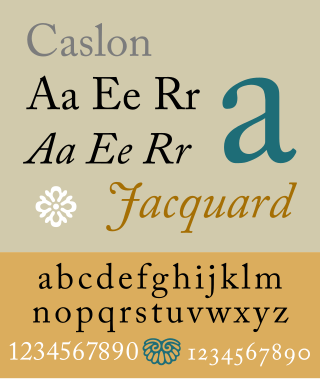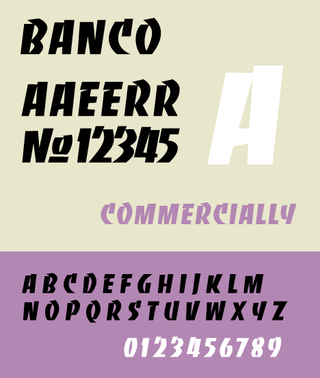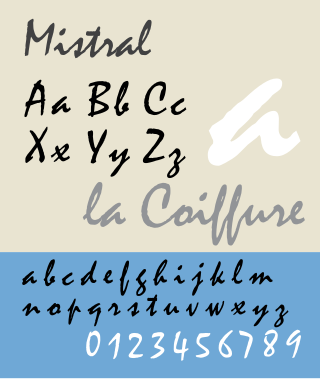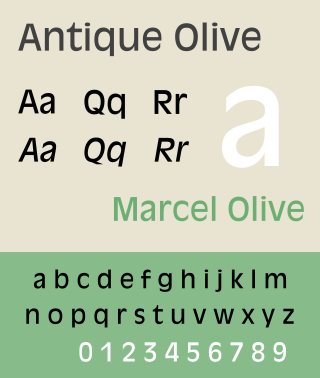Related Research Articles
Deberny & Peignot was a French type foundry, created by the 1923 merger of G. Peignot & Fils and Deberny & Cie. It was bought by the Haas Type Foundry (Switzerland) in 1972, which in turn was merged into D. Stempel AG in 1985, then into Linotype GmbH in 1989, and is now part of Monotype Corporation.

Caslon is the name given to serif typefaces designed by William Caslon I (c. 1692–1766) in London, or inspired by his work.

Banco is an inclined titling typeface. It was designed by Roger Excoffon for the Fonderie Olive foundry in 1951.

Mistral is a casual script typeface designed by Roger Excoffon for the Fonderie Olive type foundry, and released in 1953. The Amsterdam Type foundry released a version in 1955.

Peignot is a sans-serif display typeface, designed by the poster artist A. M. Cassandre in 1937. It was commissioned by the French type foundry Deberny & Peignot.

Stephenson Blake is an engineering company based in Sheffield, England. The company was active from the early 19th century as a type founder, remaining until the 1990s as the last active type foundry in Britain, since when it has diversified into specialist engineering.

Roger Excoffon was a French typeface designer and graphic designer.
Bauersche Gießerei was a German type foundry founded in 1837 by Johann Christian Bauer in Frankfurt am Main. Noted typeface designers, among them Lucian Bernhard, Konrad Friedrich Bauer, Walter Baum, Heinrich Jost, Imre Reiner, Friedrich Hermann Ernst Schneidler, Emil Rudolf Weiß, and Heinrich Wienyck, designed typefaces for the company.
The Fonderia Nebiolo was a manufacturer of printing presses and paper and formerly a type foundry. Nebiolo & Co. was created in 1878 when Giovanni Nebiolo bought out the type foundry of G. Narizzano in Turin, Italy, in 1852. In 1908 the company merged with the Urania Company and operated under the name Augustea and began to buy out many smaller foundries. In 1916 it was again renamed Società Nebiolo. In 1976 in occasion of the renovation of the Company that naturally would have come to an end that year, Fiat entered into the press manufacturing business and the Studio Artistico was closed up. In 1992 it became Nebiolo Printech S.p.A. and continues to manufacture presses under that name today.
Ludwig & Mayer was a German type foundry in Frankfurt am Main, Germany. Many important designers worked for the Ludwig and Mayer type foundry, including Heinrich Jost, Karlgeorg Hoefer, Helmut Matheis, and most notably Jakob Erbar, whose Erbar Book was one of the first geometric sans-serif typefaces, predating both Paul Renner's Futura and Rudolf Koch's Kabel by some five years. Starting in 1925, Ludwig & Mayer types were distributed in the United States by Continental Type Founders Association. When the foundry ceased operations in 1984, rights to the typefaces was transmitted to the Neufville Typefoundry.

D. Stempel AG was a German typographic foundry founded by David Stempel (1869–1927), in Frankfurt am Main, Germany. Many important font designers worked for the Stempel foundry, including Hans Bohn, Warren Chappell, F. H. Ehmcke, Friedrich Heinrichsen, Hanns Th. Hoyer, F. W. Kleukens, Erich Meyer, Hans Möhring, Hiero Rhode, Wilhelm Schwerdtner, Herbert Thannhaeuser, Martin Wilke, Rudolf Wolf, Victor Hammer, Hermann Zapf, and Gudrun Zapf von Hesse. With the introduction of Memphis in 1929, the foundry was the first to cast modern slab serif typefaces.
Konrad Friedrich Bauer was a German type designer who, though not related to founder Johann Christian Bauer, was head of the art department for the Bauer Type Foundry from 1928 until his retirement in 1968. Bauer's father was a type founder in Altona and Bauer studied art and the history of lettering before serving a printers's apprentiship. Bauer revived and modified many nineteenth-century designs and he designed Fortune the first Clarendon typeface with a matching italic. He is the author of many books on the history of design and taught book design, type and printing at the University of Mainz from 1947 until his death.
Walter Baum was a German type designer, graphic artist and teacher. Baum trained as a typesetter from 1935 to 1939. He resumed his studies after World War II before becoming head of the graphics studio at the Bauer Type Foundry in 1948. There, he collaborated with Konrad Friedrich Bauer in designing many typefaces, including Fortune, the first Clarendon typeface with a matching italic. From 1972 to 1986 he was director of the Kunstschule Westend in Frankfurt am Main.

Antique Olive is a humanist sans-serif typeface. Along the lines of Gill Sans, it was designed in the early 1960s by French typographer Roger Excoffon, an art director and former consultant to the Marseilles based Fonderie Olive. In addition to a basic weight, Antique Olive was produced in medium, condensed, wide, bold, condensed bold, extra bold, and ultra bold. The counters and bowls, especially the letter O, resemble an olive, which is one of the characteristics which make Excoffon's typefaces unique. It was used in the Sesame Street ending credits from 1978-1983 and on Cartoon Network's Ben 10: Alien Force and Ben 10: Ultimate Alien.

J.G. Schelter & Giesecke was a German type foundry and manufacturer of printing presses started 1819 in Leipzig by punchcutter Johann Schelter and typefounder Christian Friedrich Giesecke (1793-1850). The foundry was nationalized in 1946 by the new German Democratic Republic, forming VEB Typoart, Dresden.

Haas Type Foundry was a Swiss manufacturer of foundry type. First the factory was located in Basel, in the 1920s they relocated to Münchenstein.

The Amsterdam Type Foundry was a type foundry based in Amsterdam, Netherlands.
Fonderie Typographique Française was a French type foundry. Founded in Paris in 1921 following the merger of the Turlot, Durey & Berthier, Renault & Marcou, Huart, Chaix, and Saling type foundries. In 1969 it moved to Champigny-sur-Marne and took the name "Société Nouvelle de la Fonderie Typographique Française". Sold in 1974 to the Fundición Tipográfica Neufville, in Barcelona
Arnold Drescher was trained as a teacher in Auerbach in 1896 and later studied at Dresden Academy of Fine Arts from 1905 to 1907 where he became a specialised instructor for art teachers, becoming a professor in 1920. As well as working freelance as a designer, he was also employed by the Staatliche Akademie für graphische Künste und Buchgewerbe. Between 1940 and 1945, he was the Academy's director. As well as being a typographer, he was a prolific painter and illustrator, designing posters for the East German government. In 1960 he retired to Braunschweig where he later died.

Jacques François Rosart was a punchcutter, engraver and founder of metal type from modern Belgium.
References
- ↑ Jaspert, W. Pincus, W. Turner Berry and A.F. Johnson. The Encyclopedia of Type Faces. Blandford Press Lts.: 1953, 1983, ISBN 0-7137-1347-X, p. 2408-249